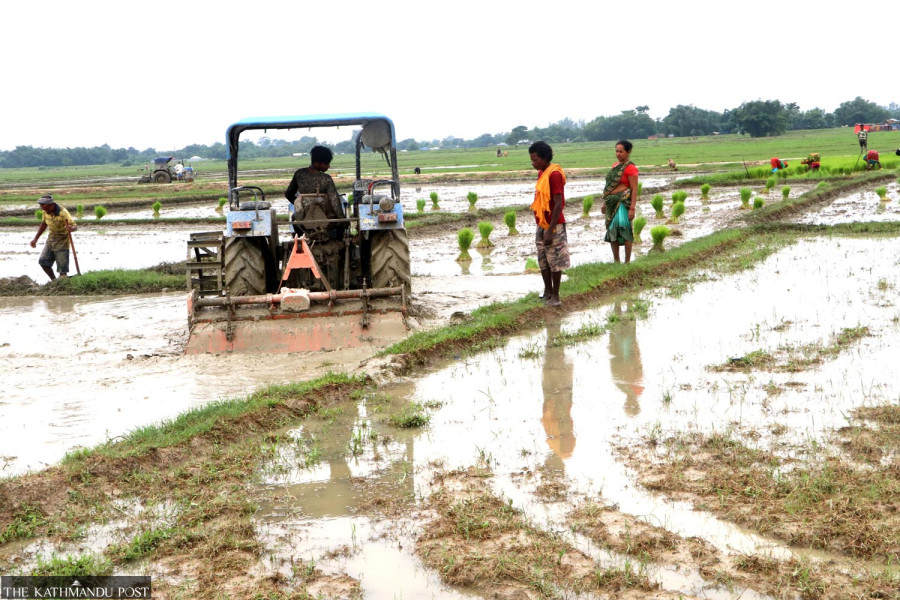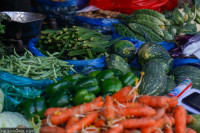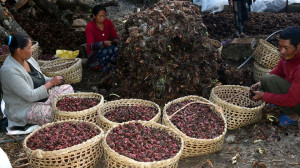Money
Downpour spurs recovery in paddy output across Nepal’s largest food baskets
Prolonged drought had stalled planting, but last week’s rains have accelerated transplantation and eased water shortages.
Sangam Prasain
The heavy downpour last week has raised renewed hopes for a significant recovery in paddy harvests in Madhesh and Koshi provinces, Nepal’s top food-producing regions.
These two provinces, Nepal’s largest food baskets, had been reeling under a prolonged drought for weeks following an intense pre-monsoon period.
According to the data of the Ministry of Agriculture and Livestock Development published on Monday, paddy transplantation across Nepal, as of August 10, has reached 91 percent.
In Madhesh, it has crossed 76 percent, while Koshi stands at 94.42 percent.
The revised data by Madhesh Province’s Agriculture Ministry said paddy transplantation has crossed 80 percent in Madhesh, though lowest among all provinces.
“There was continuous rainfall last week, and it rained heavily on Saturday,” said Ajaya Gyawali, information officer at Madhesh Province’s Agriculture Ministry. “The heavy rainfall allowed farmers to transplant paddy, and now it has crossed 80 percent of the total fields. We could cross 90 percent if the rain continues by this week.”
Madhesh has 285,234 hectares of paddy fields spread across Saptari, Siraha, Dhanusha, Mahottari, Sarlahi, Rautahat, Bara, and Parsa districts.
“In a worst-case scenario, if drought returns after transplantation, output may drop by around 10 percent in Madhesh,” said Gyawali, who is also an agricultural economist. “But it’s still too early to predict given the ongoing recovery.”
Experts note that paddy can be transplanted or sown in the southern Tarai until mid-September, so there is no immediate threat to production losses unless severe drought sets in.
Last year, Nepal recorded one of its fastest transplantation rates in decades due to “above-normal” rainfall. This year’s pace has slowed, mainly because of a rainfall deficit in Madhesh and Koshi.
Rice expert Rajendra Upreti said there is still time for transplantation in the southern Tarai, and with regular rainfall and adequate fertiliser supply, production should hold steady.
“Madhesh’s productivity is already among the lowest—about 3.49 tonnes per hectare—so the impact of delayed planting is less severe compared to provinces with higher yields,” he said. “If the productivity were 7–8 tonnes per hectare, delays would be more concerning.”
Large parts of Madhesh, especially from Siraha to Mahottari, are chronically dry due to limited irrigation. The Bagmati, Kamala, and Narayani rivers, along with the Chandra Canal, remain the main water sources, with no other reliable perennial supply.
To address irrigation shortages, the federal government has launched the Rs87 billion Sunkoshi Marin Diversion Project, which aims to channel water from the Sunkoshi River to the Bagmati River to irrigate 122,000 hectares in Rautahat, Dhanusha, Mahottari, Sarlahi, and Bara.
Of the total investment, Rs37.3 billion is allocated for irrigation infrastructure, which was declared a national pride project in January 2020 and scheduled for completion by July 2027. A major milestone—the Rs10.05 billion, 13.3-km diversion tunnel—was completed six months ahead of schedule in May last year.
However, officials admit that other irrigation works have progressed slowly.
Except for the last two years, when heavy monsoon rains boosted yields, Madhesh fields have often remained parched.
Last year’s record harvest of 5.94 million tonnes of paddy was mainly driven by Madhesh’s contribution, which received regular and heavy rains. Madhesh accounts for one-fourth of Nepal’s total paddy production.
As of August 9, paddy transplantation across Nepal had reached 91 percent of the 1.37 million hectares of available paddy fields.
Historically, the mid-August average of paddy transplantation is around 94 percent, except for the past two years, when it hit 98 percent.
According to the federal Agriculture Ministry, transplantation in Madhesh is at 76.54 percent of available fields, compared to 97 percent at the same time last year.
Provincial figures, however, put the current rate at over 80 percent, boosted by Saturday’s heavy rainfall.
Other provinces report higher completion rates: Sudurpaschim (99.72 percent of 176,151 hectares), Karnali (98.4 percent of 41,042 hectares), Lumbini (98 percent of 302,939 hectares), Koshi (94.42 percent of 276,386 hectares), Bagmati (93.56 percent of 115,621 hectares), and Gandaki (92.77 percent of 94,182 hectares).
Monsoon rains are vital for Nepal’s Rs6.17 trillion economy. They deliver nearly 80 percent of the water essential for agriculture and replenish reservoirs and aquifers.
As nearly half of Nepal’s farmland lacks irrigation, the June-September rains play a pivotal role in crop production. The monsoon is therefore seen as a critical macroeconomic factor, closely monitored by investors, policymakers, and consumers alike.
As Nepal’s economy heavily relies on rural areas, monsoon performance directly influences consumer spending.
The agricultural sector contributes about 23.9 percent of Nepal’s GDP and employs over 60 percent of the population.
Experts emphasise that timely and above-normal monsoon rains improve the speed and success of crop transplantation, resulting in higher yields. Greater output usually leads to lower food prices, helping to keep inflation within the government’s target range.
It also increases rice availability, potentially allowing countries like Nepal to import less.
This year, Nepal saw regular and heavy pre-monsoon rains, and the monsoon arrived early on May 29—two weeks ahead of schedule.
Yet large parts of Madhesh remained dry for more than six weeks afterwards, triggering an unexpected drought despite forecasts of above-average rainfall.
Water sources dried up, groundwater levels fell, and drinking water and irrigation became scarce.
On July 23, the federal government declared all 136 municipalities in Madhesh drought-affected. Subsequently, on July 26, the prime minister conducted an aerial survey of the drought-hit areas, where agricultural fields had dried up and residents queued for water.
A forecast on July 31 predicted moderate to heavy rainfall in August.
“It’s raining now,” Gyawali said. “It’s a big respite for people and agriculture.”




 6.1°C Kathmandu
6.1°C Kathmandu















